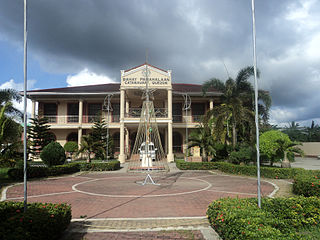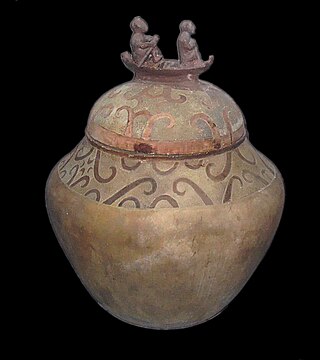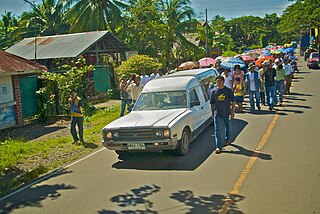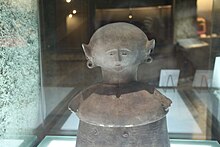
Sarangani, officially the Province of Sarangani, is a province in the Philippines located in the Soccsksargen region. Its capital is Alabel while Glan is the most populous municipality in the province. With a 230-kilometer (140 mi) coastline along the Sarangani Bay and Celebes Sea, the province is at the southernmost tip of Mindanao island, and borders South Cotabato and Davao del Sur to the north, Davao Occidental to the east, and the Celebes Sea to the south.

Soccsksargen, formerly known as Central Mindanao, is an administrative region of the Philippines, designated as Region XII. Located in south-central Mindanao, its name is an acronym that stands for the region's four provinces and one highly urbanized city. The regional center is in Koronadal, located in the province of Cotabato del Sur, and the center of commerce and industry is General Santos, which is the most populous city in the region.

The Plain of Jars is a megalithic archaeological landscape in Laos. It consists of thousands of stone jars scattered around the upland valleys and the lower foothills of the central plain of the Xiangkhoang Plateau. The jars are arranged in clusters ranging in number from one to several hundred.

Maitum, officially the Municipality of Maitum, is a 2nd class municipality in the province of Sarangani, Philippines. According to the 2020 census, it has a population of 44,185 people, making it the least populated municipality in the province.

Catanauan, officially the Municipality of Catanauan, is a 1st class municipality in the province of Quezon, Philippines. According to the 2020 census, it has a population of 72,752 people.

The Tabon Caves is a cave system located in Lipuun Point, Panitian, Quezon, Palawan in the Philippines. Dubbed as the country's "cradle of civilization", it is a site of archaeological importance due to the number of jar burials and prehistoric human remains found starting from the 1960s, most notably the Tabon Man. The system is a part of the Lipuun Point Reservation, which has been protected by the Philippine government as a museum reservation to protect the caves and its immediate vicinity from deforestation and to preserve the cultural artifacts present there.

The Manunggul Jar is a secondary burial jar excavated from a Neolithic burial site in the Manunggul cave of the Tabon Caves at Lipuun Point in Palawan, Philippines. It dates from 890–710 B.C. and the two prominent figures at the top handle of its cover represent the journey of the soul to the afterlife.

Gatecliff Rockshelter (26NY301) is a major archaeological site in the Great Basin area of the western United States that provides remarkable stratigraphy; it has been called the "deepest archaeological rock shelter in the Americas". Located in Mill Canyon of the Toquima Range in the Monitor Valley of central Nevada, Gatecliff Rockshelter has an elevation of 7,750 feet (2,360 m). David Hurst Thomas discovered Gatecliff Rockshelter in 1970 and began excavations in 1971. Full scale excavations occurred at Gatecliff Rockshelter for about seven field seasons in which nearly 33 feet (10 m) of sediments were exposed for a well-defined stratigraphic sequence. The well-preserved artifacts and undisturbed sediments at Gatecliff Rockshelter provides data and information have been applied to a range of research topics. Based on the analysis of the artifacts at Gatecliff Rockshelter, it can be determined that it was most likely a short-term field camp throughout prehistory. The latest evidence for human usage at Gatecliff occurs between ca. 5500 B.P. to 1250 B.P.

Việt Khê is an archaeological site in the Red River Delta in northern Vietnam. Excavations there yielded a number of coffins containing relics of the Dong Son culture in Bronze Age. The Việt Khê construction site is located on the southern base of a hill which overlooks the Hàn River near Thủy Nguyên District, Haiphong. Five wooden coffins were excavated in 1961, each of which were aligned in the east-west direction, with at least two pairs of coffins being configured in a linear manner.

The cultural achievements of pre-colonial Philippines include those covered by the prehistory and the early history (900–1521) of the Philippine archipelago's inhabitants, the pre-colonial forebears of today's Filipino people. Among the cultural achievements of the native people's belief systems, and culture in general, that are notable in many ethnic societies, range from agriculture, societal and environmental concepts, spiritual beliefs, up to advances in technology, science, and the arts.

The prehistory of the Philippines covers the events prior to the written history of what is now the Philippines. The current demarcation between this period and the early history of the Philippines is April 21, 900, which is the equivalent on the Proleptic Gregorian calendar for the date indicated on the Laguna Copperplate Inscription—the earliest known surviving written record to come from the Philippines. This period saw the immense change that took hold of the archipelago from Stone Age cultures in 50000 BC to the emergence of developed thalassocratic civilizations in the fourth century, continuing on with the gradual widening of trade until 900 and the first surviving written records.

During the Pre-Hispanic period the early Filipinos believed in a concept of life after death. This belief, which stemmed from indigenous ancestral veneration and was strengthened by strong family and community relations within tribes, prompted the Filipinos to create burial customs to honor the dead through prayers and rituals. Due to different cultures from various regions of the Philippines, many different burial practices have emerged. For example, the Manobos buried their dead in trees, the Ifugaos seated the corpse on a chari before it was brought to a cave and buried elsewhere. The most common forms of traditional burials are supine pits, earthenware jars, and log coffins, and have been a topic of interest among Philippine archaeologists since the early 20th century.
The Brentwood Library Site (40WM210), also known as the Jarman Farm Site, is a Mississippian culture archaeological site located in the city of Brentwood, in Williamson County, Tennessee. The substantial town was occupied during Regional Period IV of the local Mississippian chronology, and there was an associated burial ground, where nearly 50 stone box graves have been found. Artifacts from the site have been radiocarbon dated to between 1298 and 1465 CE. These include several types of Mississippian pottery, with Beckwith Incised found in the highest number.
Dewil Valley, located in the northernmost part of Palawan, an island province of the Philippines that is located in the Mimaropa region, is an archaeological site composed of thousands of artifacts and features. According to the University of the Philippines Archaeological Studies Program, or UP-ASP, the closest settlement can be found in New Ibajay, which is covered by the town capital of El Nido, which is located around 9 km (5.6 mi) south-east of Dewil Valley. Physically it measures around 7 km (4.3 mi) long, and 4 km (2.5 mi) wide. It is in this place which the Ille Cave, one of the main archaeological sites, can be found. It is actually a network of 3 cave mouths located at its base. It has been discovered that this site in particular has been used and occupied by humans over multiple time periods.

Pampanga lies within the Central Plain region and has a total land area of 2,180.70 square kilometers. Together with Bulacan, Nueva Ecija, Pangasinan and Tarlac, the region includes a total area of approximately 5,900 square miles, mostly composed of lowlands and arable areas.

Sarangani is a province located in the Mindanao region of the Philippines and has a total land area of 4,441.79 square kilometers.. Historically, Sarangani already had an established community even before the Westerners came. The early Sarangani society was greatly affected by the Indian and Muslim cultures, and the first inhabitants were the indigenous natives called
Shell tools, in the archaeological perspective, were tools fashioned by pre-historic humans from shells in lieu of stone tools. The use of shell tools during pre-historic times was a practice common to inhabitants of environments that lack the abundance of hard stones for making tools. This was the case with the islands surrounding the Pacific, including the Philippines. Shells were fashioned into tools, as well as ornaments. From adzes, scoops, spoons, dippers and other tools to personal ornaments such as earrings, anklets, bracelets and beads. These different artefacts made of shells were unearthed from various archaeological sites from the country.

The archaeology of the Philippines is the study of past societies in the territory of the modern Republic of the Philippines, an island country in Southeast Asia, through material culture.

Philippine ceramics refers to ceramic art and pottery designed or produced as a form of Philippine art.
Philippine ceramics are mostly earthenware, pottery that has not been fired to the point of vitrification. Other types of pottery like tradeware and stoneware have been fired at high enough temperatures to vitrify. Earthenware ceramics in the Philippines are mainly differentiated from tradeware and stoneware by the materials used during the process and the temperature at which they are fired. Additionally, earthenware and stoneware pottery can generally be referred to as ceramics that are made with local materials, while tradeware ceramics can generally be referred to as ceramics that are made with non-local materials.


















